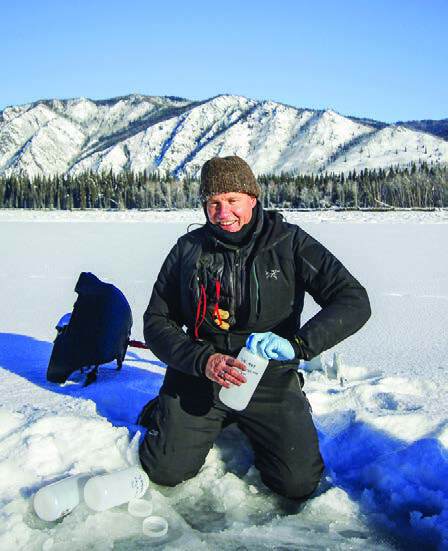
Scientists from environmental consultant Hemmera are filtering environmental DNA (eDNA) from waterways throughout Western and Northern Canada to map habitat use for vulnerable species in stream and river habitats. Hemmera hopes to work with mining clients to demonstrate how they can use eDNA technology to better design, plan and progressively reclaim mining projects across the North.
What is eDNA? It is the genetic material such as feces, urine, mucus and skin cells that an organism leaves behind in a waterbody. With eDNA, the species under study does not need to be present at the time of sampling; a water sample collected within several weeks of a species’ presence is enough to confirm that species’ DNA in the waterbody. This low-cost, non-invasive method for collecting and analyzing data is providing critical new information on the distribution of vulnerable species in aquatic habitats throughout Western Canada.
Hemmera is proposing the use of eDNA to support progressive reclamation planning for mining projects. “Depending on the operation, reclamation can take place while a mine is still in operation, including re-establishing waterways and construction of waterbodies,” explains Katherine Gizikoff, mining lead for Western Canada at Hemmera. Gizikoff points to the power of eDNA to reduce costs for species’ detection in aquatic environments. “Our proposed use of eDNA in progressive reclamation will help mine owners throughout a mine’s life cycle to detect species of interest and make more informed decisions to re-establish species of interest at a fraction of the cost of conventional detection methods. This demonstration of success will support the mine’s reclamation plans for closure.”
Mineral exploration companies can also benefit from the use of eDNA during baseline data collection or during a project’s preliminary exploration stages. Use of eDNA in waterbodies near a proposed mine provides exploration companies with a low-cost method of confirming species’ presence or absence in the environment. This data and confirmation can result in more informed decisions for both exploration companies and communities when considering potential effects of a proposed mine on a receiving environment – particularly environments that support species at risk. In addition, once preserved, eDNA samples can be analyzed even years after the initial collection, filtration and preservation, enabling retroactive analysis of samples for other species that may be identified as a management concern in the future.
Recently, Hemmera undertook eDNA studies to assess the presence of Arctic grayling (Thymallus arcticus) and Chinook salmon (Oncorhynchus tshawytscha) in Yukon waterbodies and watercourses. The assessment of potential project-related effects of a proposed mine on fish and fish habitat used eDNA sampling and analysis to supplement existing information derived using conventional fish survey methods. More than a dozen sites were assessed in northern Yukon using eDNA methods to better determine winter use of these waterbodies by both Arctic grayling and Chinook salmon. Ultimately, eDNA provided a powerful, robust, scientifically defensible and cost-effective method of determining whether Chinook salmon or Arctic grayling use aquatic habitats near the proposed mine site.

Jared Hobbs, a senior biologist at Hemmera, is leading the development and implementation of Hemmera’s eDNA studies. Working with other scientists at Hemmera and elsewhere, Hobbs has completed more than 40 eDNA projects across British Columbia and Yukon, and has authored a B.C. provincial standard for the B.C. Ministry of Environment and Climate Change Strategy to provide guidance on improving rigour for eDNA practitioners. This standard has been informed by Hemmera’s project successes and incorporates methods, techniques and guidance from previous projects and collaborations with two genetics laboratories.
“We conduct eDNA studies differently at Hemmera,” explains Hobbs. “Our objective with eDNA technology, from the outset, has been to work diligently with our university and laboratory partners to develop the most rigorous methodological approach possible to provide defensible results that project proponents, regulators, First Nations and other interested parties can rely on. The robust field and lab methods we have developed with our university partners provide clear direction and protocols to produce results that are reliable and accurate.”
In addition to training other practitioners in the use of eDNA, Hobbs is also involved in many eDNA projects for clients across Northern and Western Canada. The eDNA work that he and other Hemmera scientists have completed on northern mining projects and other private- and public-sector projects represents some of the first applications of eDNA in B.C. and Yukon’s formal environmental assessment processes. Results have been used to inform conservation and management of species at risk and have been applied in both regulatory and conservation frameworks, in addition to informing the design, management and ultimate reclamation of mining projects.
